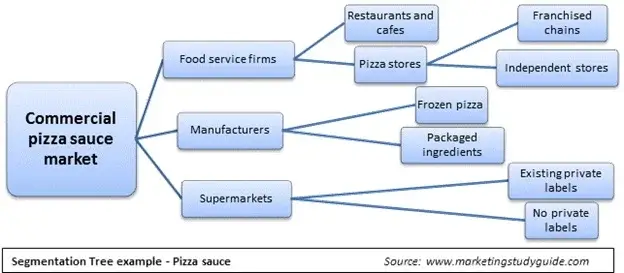I’m amazed at how many savvy business people don’t know how to properly implement market segmenting before developing a marketing plan. I’m even more surprised that most just assume “everyone” will buy their products or sign up for their services.
In fact, a study done by Harvard Business claimed that in the US, 85% of 30,000 new product launches failed because of poor market segmentation.
Marketing segmentation is a marketing strategy that involves dividing a broad target market into subsets of consumers who have common needs and application for the relevant goods and services.
Marketing campaigns are then designed and implemented to target these specific customer segments.
Why Should You Care About Market Segmentation?
One of the main reasons to use market segmentation is to gain a competitive advantage by understanding the needs of a specific customer base. Many mass marketing techniques that are used assume all customers are the same.
This isn’t ideal.
It’s not that results aren’t attainable through mass marketing, it’s just not as an efficient process as market segmentation. Correctly using market segmentation allows you to better know your customer base, and align your marketing efforts and messaging strategy.
Strategic Planning: Common Segment Descriptors
Descriptors are customer characteristics, used during the strategic planning phase, that are significant enough to divide your market. You won’t use all of these descriptors for every campaign, but you should know them.
- Psychographic: Grouping your customers into cultural clusters, social status, lifestyle and personality type.
- Decision Makers: Grouping your customers based on who decides to purchase your product within the company structure.
- Behavioral: Grouping customers by product usage. For example; light, medium or heavy users. This stage also factors in brand loyalty and the type of user.
- Geographic: Grouping customers by a specific area, such regions of the country or state and urban or rural.
- Distribution: Grouping customers based on where they go to purchase your product, such as online, store or through a catalog.
- Demographic: Grouping customers by age, income level, gender, family size, religion, race, nationality, language, etc.
Market Segmenting Best Practices: 4 Simple Rules
Market segmentation doesn’t have to be as difficult as most business professionals make it. The process just takes time and research. It is important to prepare and do your research upfront to truly determine your segments and then align with marketing efforts.
Four Simple Rules for Market Segmentation
- 1. Don’t define your segments too broadly. This will give you a greater opening to a competitor who targets more narrowly.
- 2. Organize your business by market segments. Many begin by establishing market-focused teams or groups which later get organized into a market-focused business model.
- 3. Manage your segments globally. Sometimes regional organization can set you up to be blind-sided later by a more dynamic global economy.
- 4. Complete your analysis and research (strategic market segment portfolio), then be bold about attacking those segments.
Good vs. Bad Market Segmentation Research
So at this point, you are probably asking yourself; what am I doing wrong? What is good market segmentation? Good market segmentation research should provide your company with a clear direction to move forward with and an idea of which markets will be best to target. The market your research shows to target should represent a high share of potential profitability to the company. It should also be easy to identify among the population of research.
If your market segmentation research is not meeting the above requirements, then that is what you’re doing wrong. You’ll need to re-gather your research team and clearly define their goals and the information they should be gathering from their market segmentation research.
Bad market segmentation research is a waste of your time, money and energy. Therefore, it is worth investing in a team or educating yourself, so you can clearly define your segments, and properly market to them. These segments should be ones your competitors don’t even know exist. This end goal will dramatically improve your marketing efforts – in tern – boosting your market share and profits.
Implementing a Better Market Segmentation Plan
There are 4 main stages that need to be considered when implementing or revising your market segmentation plan:
1. Objective Setting
- Set segmentation objectives and goals
- Identify segmentation variables and develop hypothesis
2. Identify Customer Segments
- Research design
- Data collection
- Analyze data and identify segments
- Validate all results
3. Develop Segmentation Strategy
- Select target segment
- Identify segmentation implications & recommendations
4. Execute Go-To-Market Plan (launch plan)
- Identify key stakeholders
- Develop communications & operational launch plan
- Execute and monitor
As you can see by the above breakdown, within each stage there are sub-steps that need to be thought about before moving on to the next stage.
Most marketers fall short during the first two stages. The research and data collection, though often rushed, is the most important stage of the implementation process of market segmentation.
Market Segmentation Example
After you work through implementing your marketing segmentation plan, it would be typical to see something like the below diagram to demonstrate to your team and all parties involved.
This example shows you the possible markets your product or service can be broken down into after all the research has been done and analyzed. It also demonstrates how far you can break down a particular segment, which is crucial to truly finding your target market and adapting a marketing plan to align with it.

Final Thoughts
“Beautiful product development in an ugly market segment simply makes no sense.” – Dan Adams
Most people do not understand their customer groups well enough to do full-blown market segmentation and that’s OK. Knowing and admitting that is half the battle. As you grow, you will learn more about each customer group and then further be able to make “spotlight” assessments on what segments look the most attractive for your business.
Keep in mind, you do not need to be an expert, but you do need to be able to admit that you may be doing things wrong and try to improve on those areas. Typically, for most businesses, market segmentation and research is one of those areas.
This is just the beginning of an effective campaign. Once you’ve created segments, it’s time to move on and create a buyer persona. From there, you can look at targeting your potential customers in social media, and nurturing those leads into sales!

